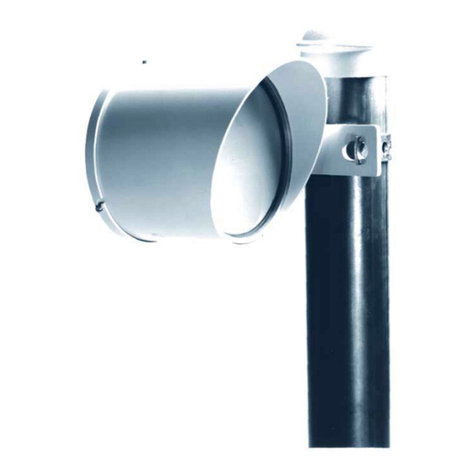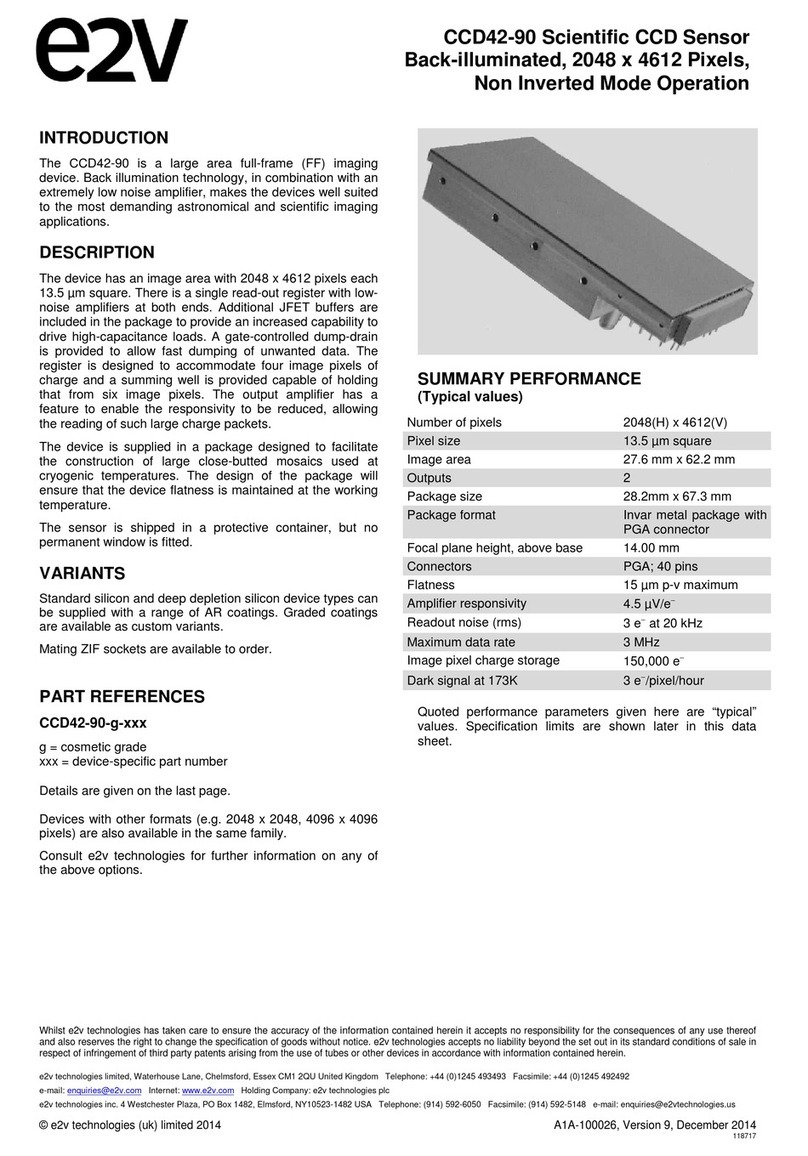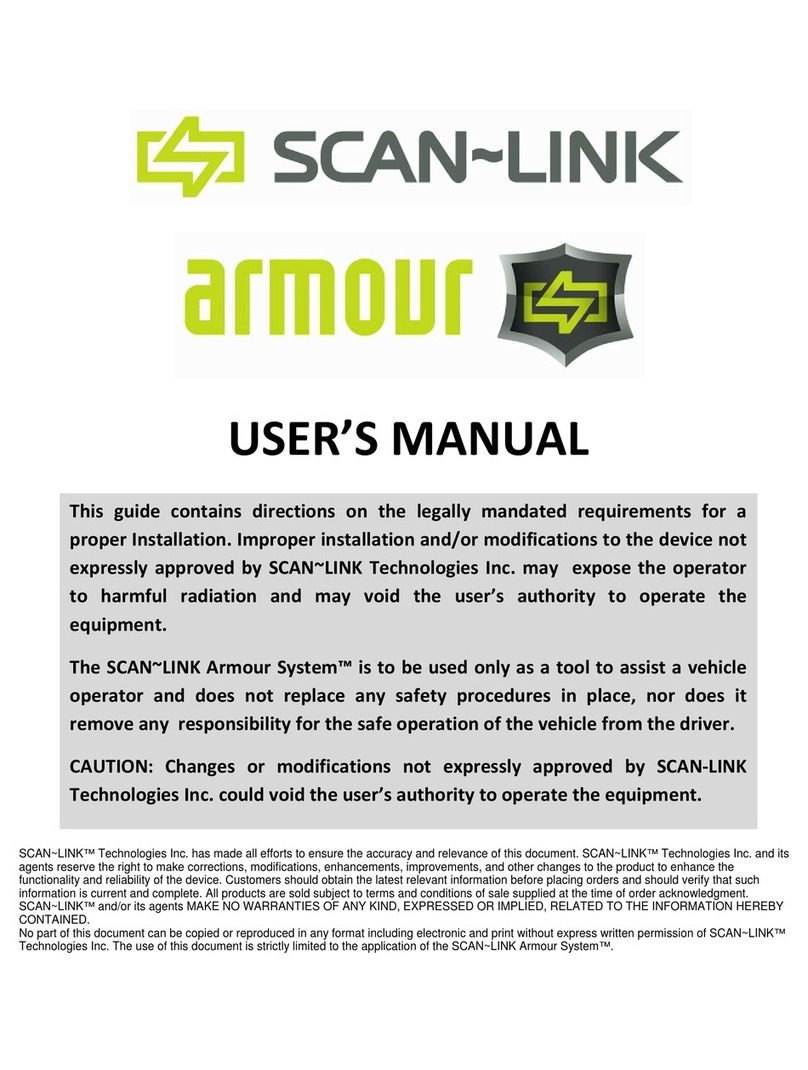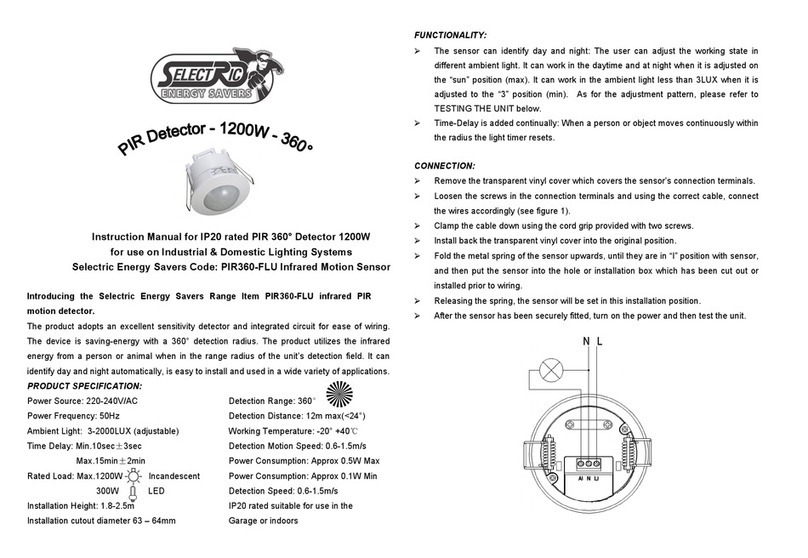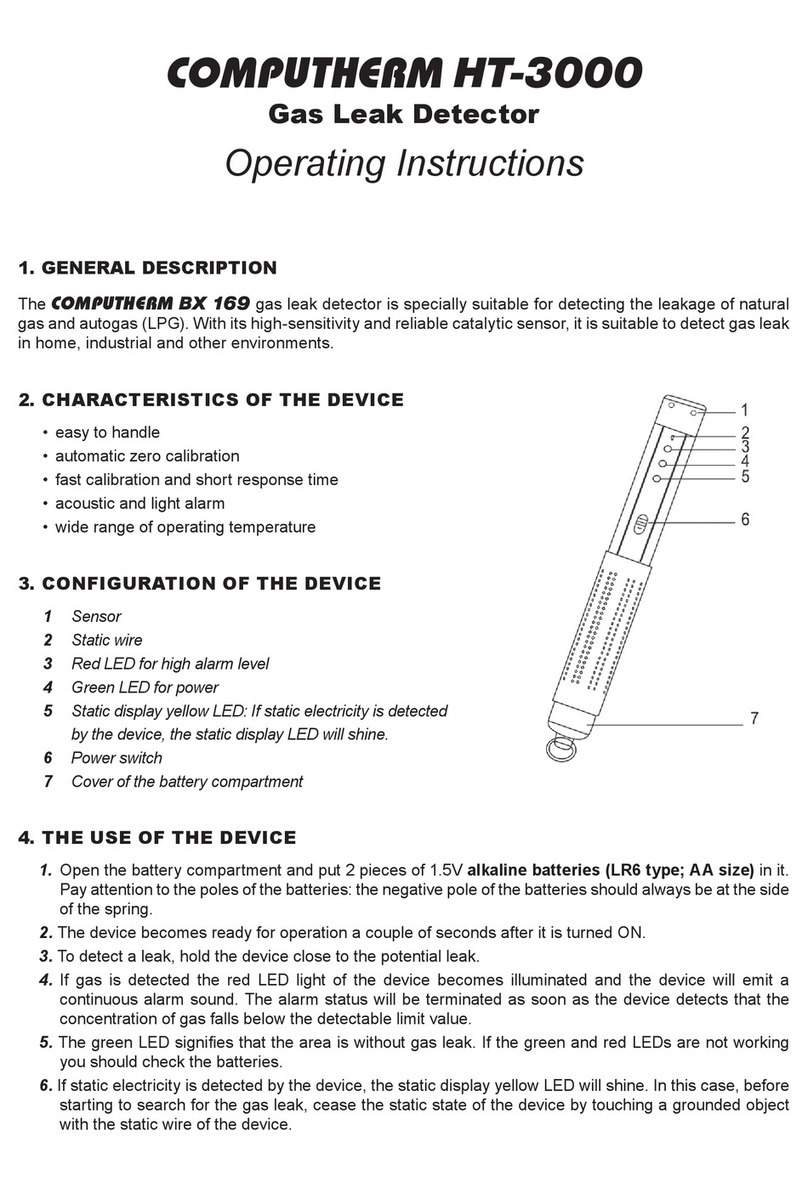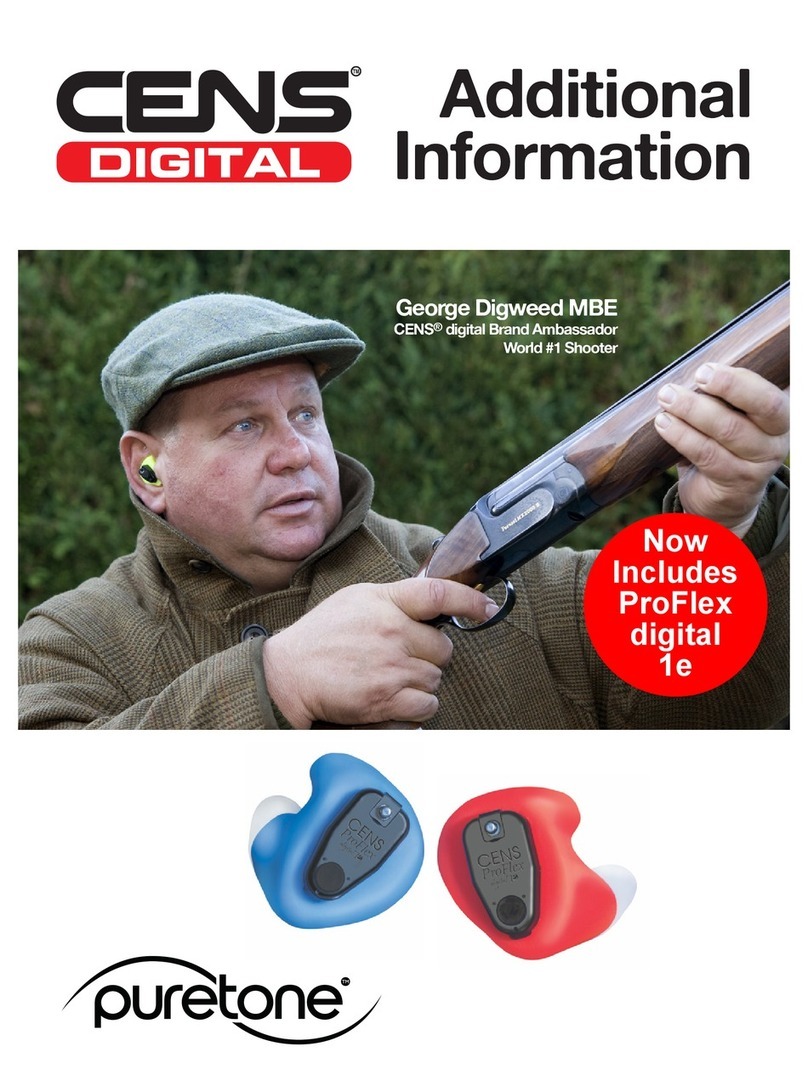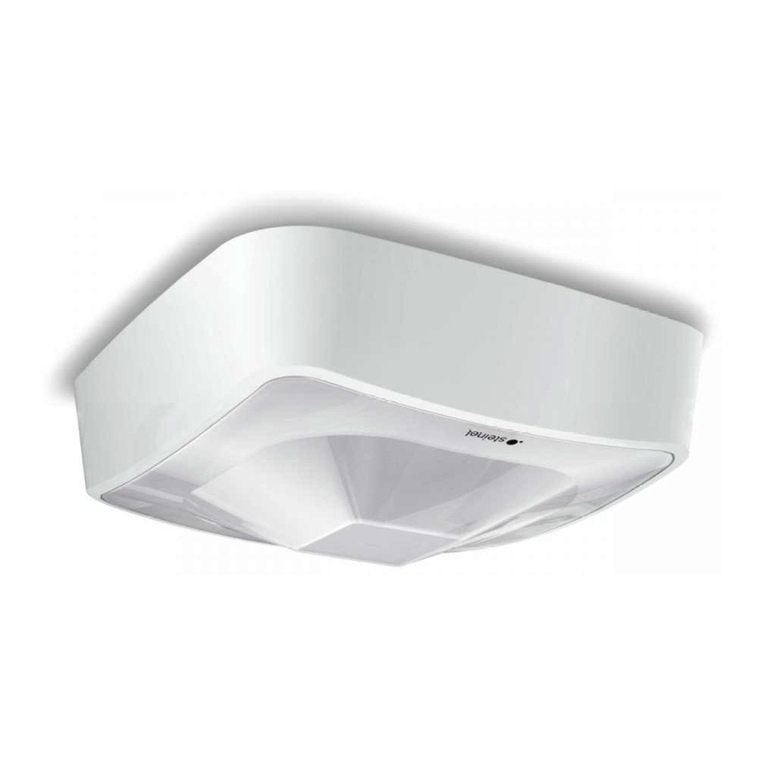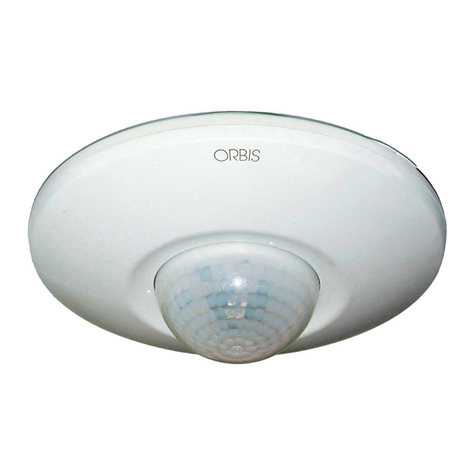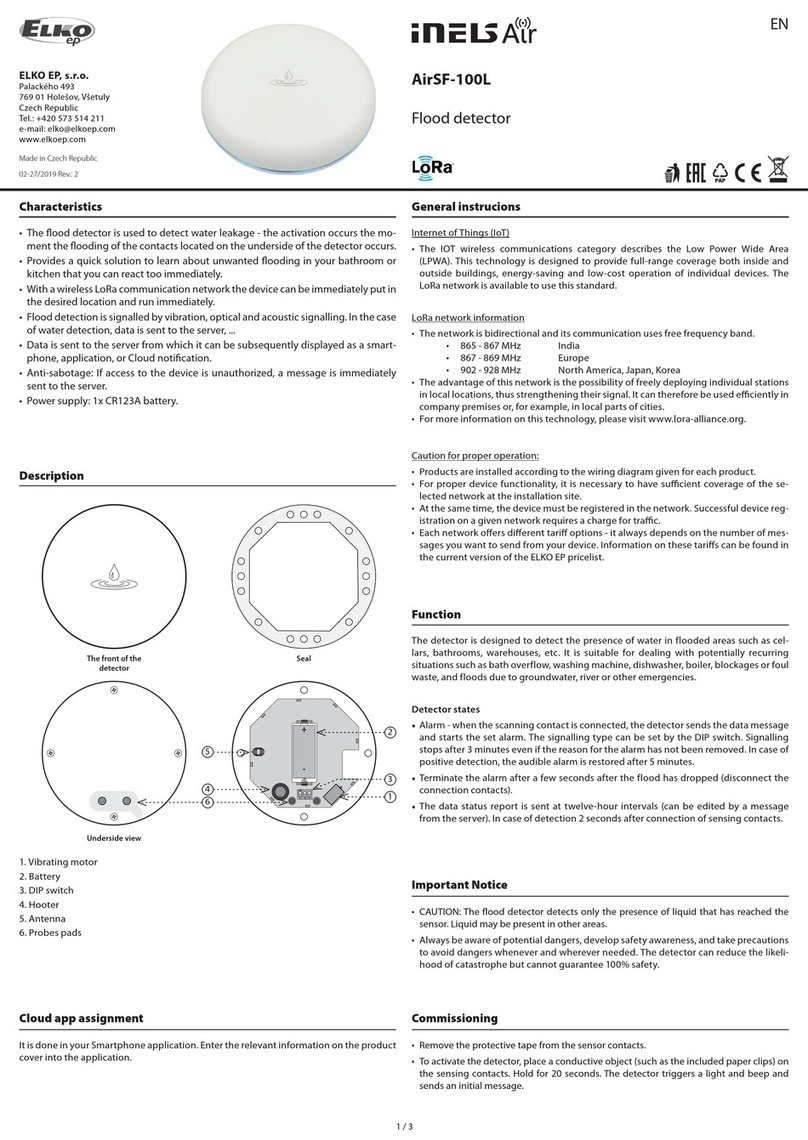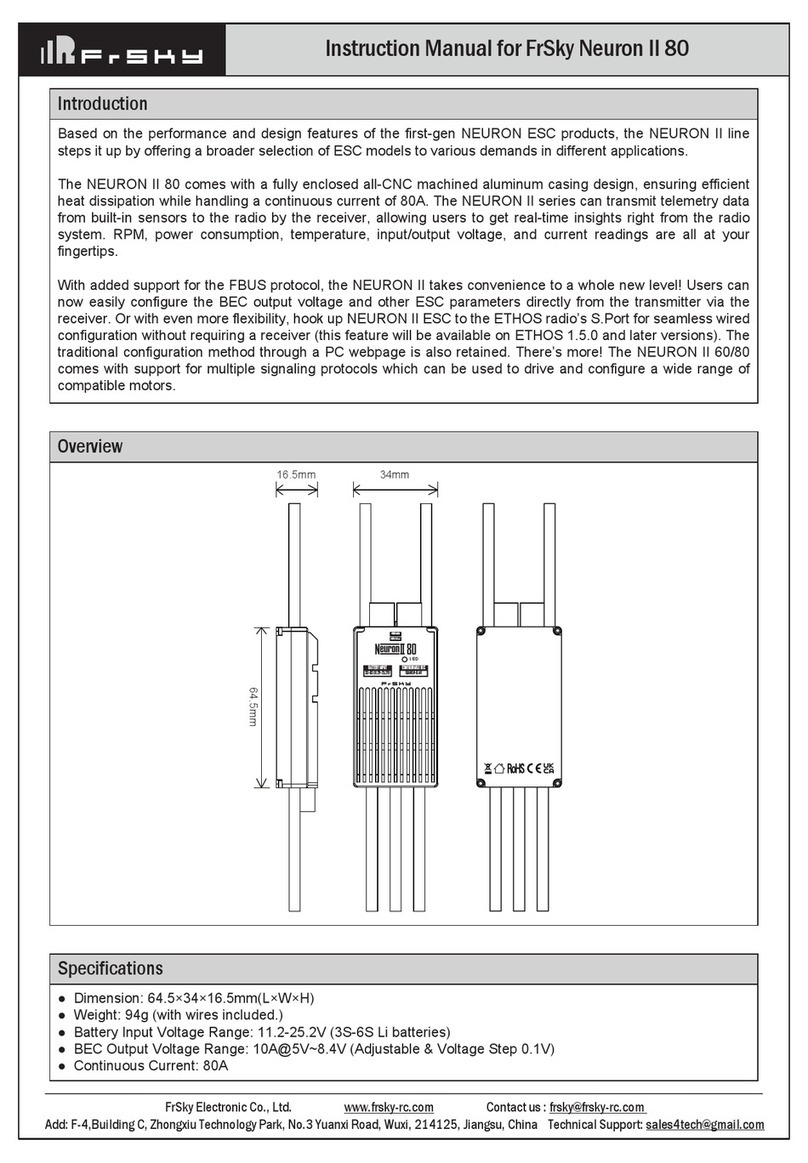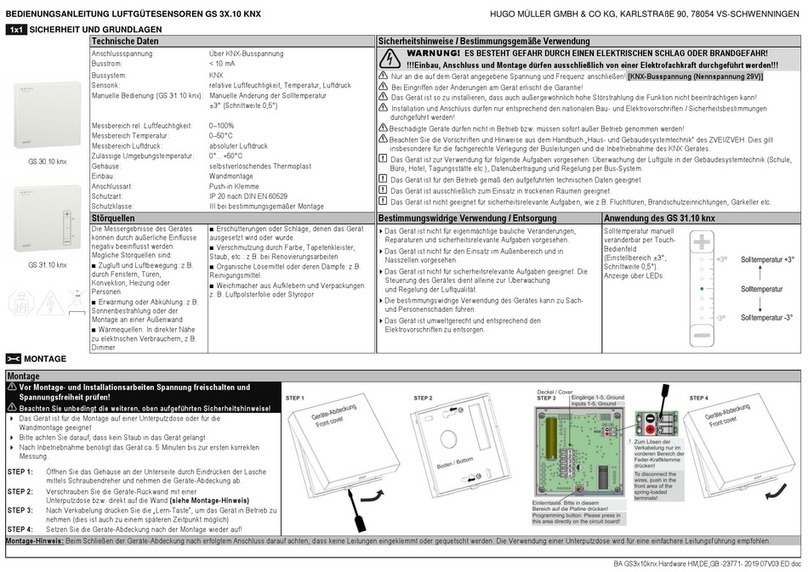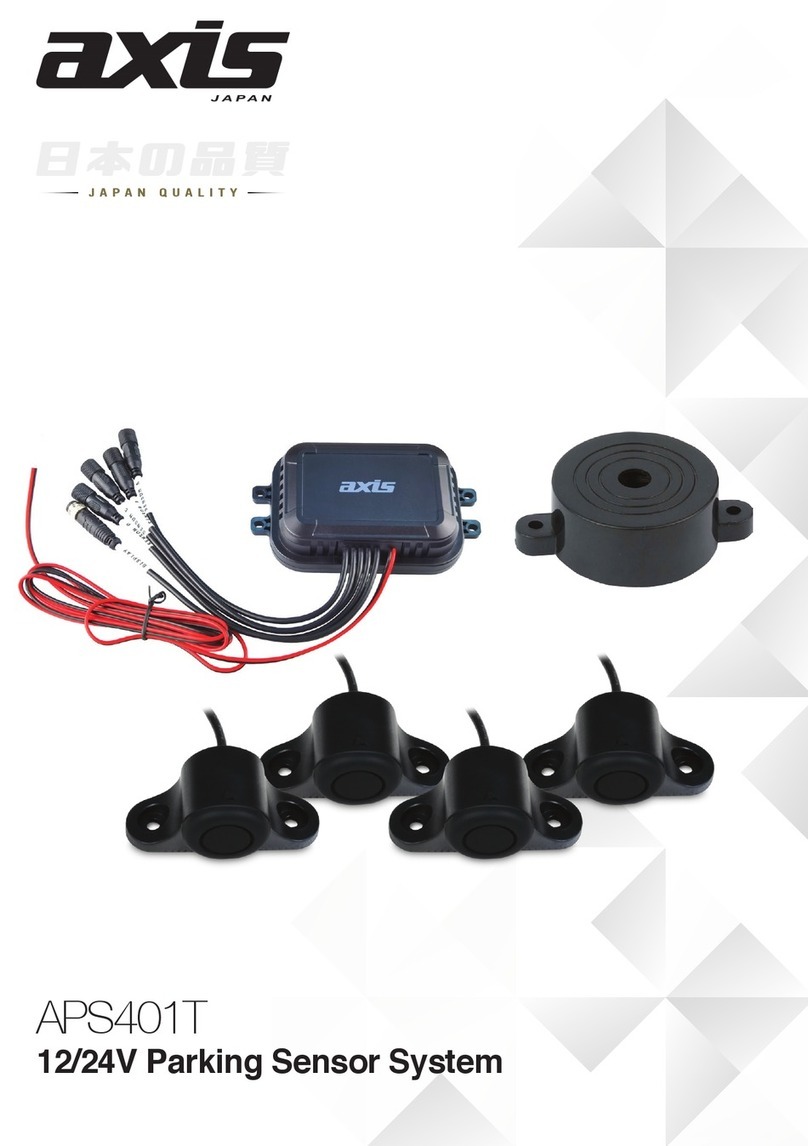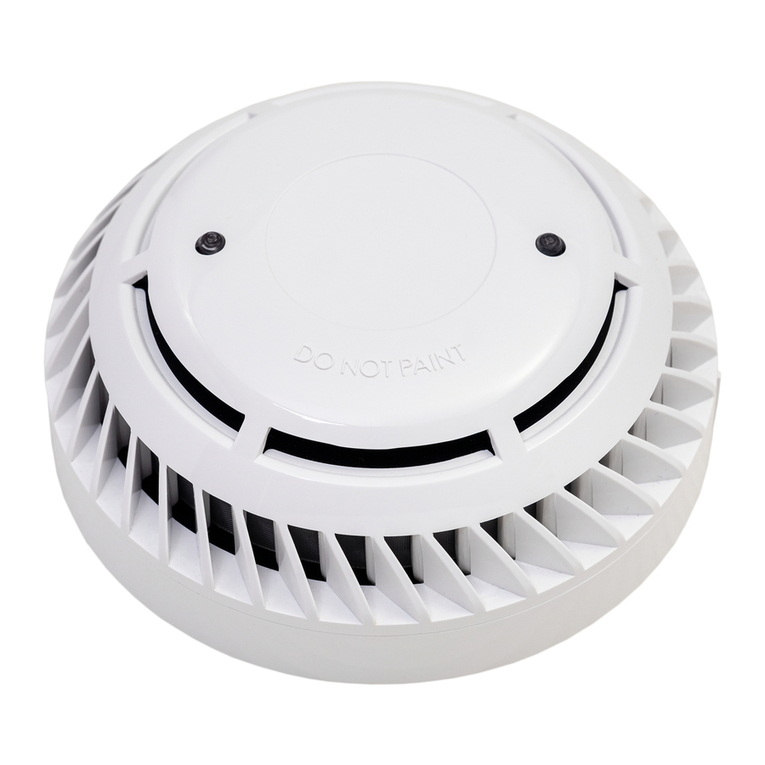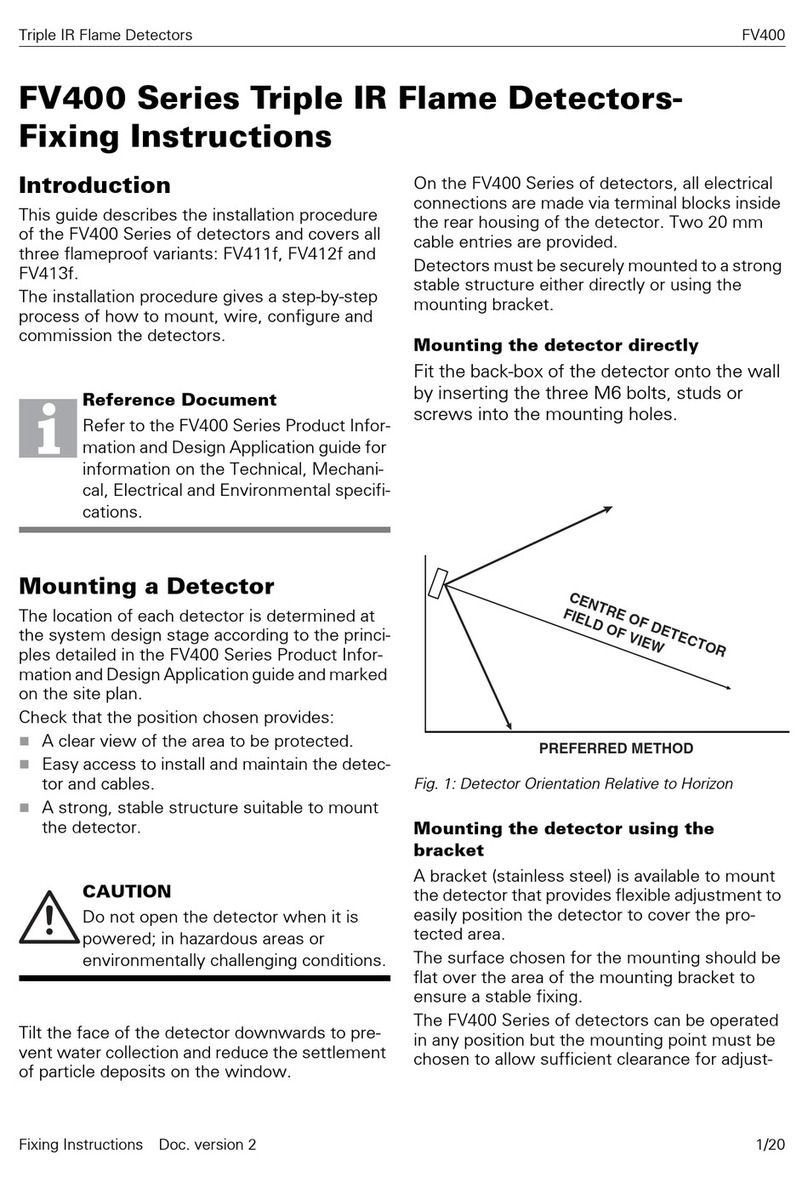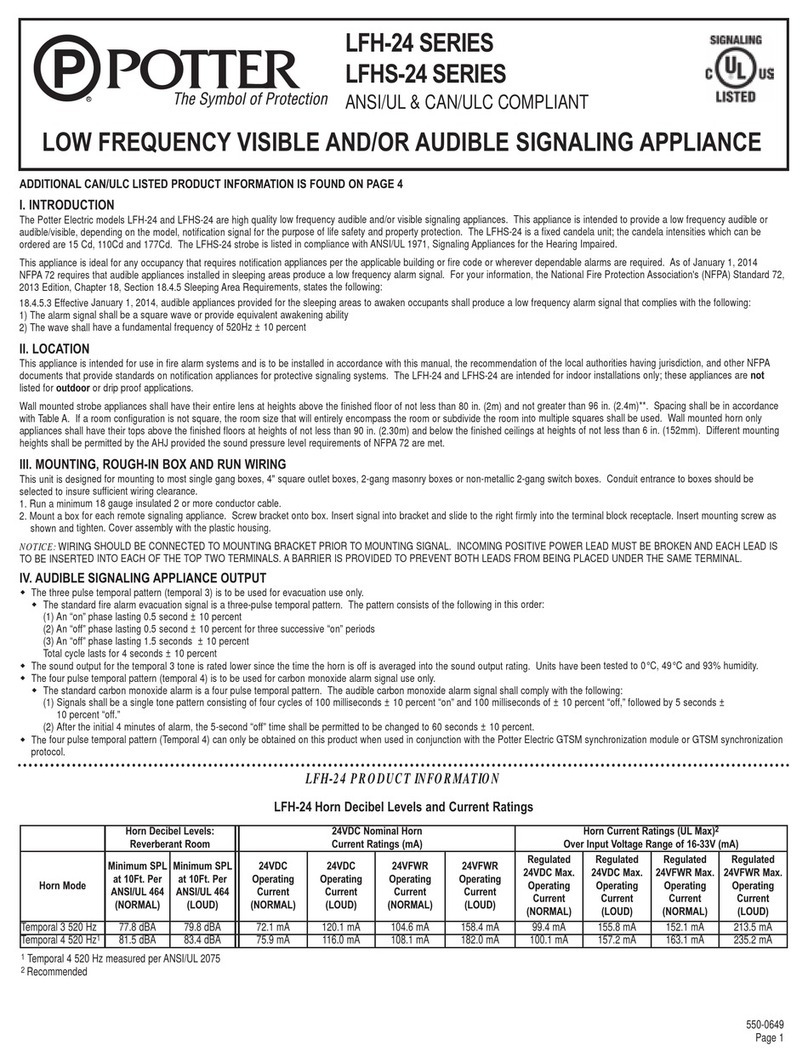SENSTAR UltraWave E4FG0101 User manual

Product
Guide
UltraWave®
Microwave Detection Sensor
E4DA0402-001, Rev E
August 27, 2019

UltraWave Product Guide
Senstar Corporation
Website: www.senstar.com
Email address: info@senstar.com
E4DA0402-001, Rev E
August 27, 2019
µltraWave, Senstar and the Senstar logo are registered trademarks, and Silver Network is a trademark of Senstar Corporation.
Product names and Company names included in this document are used only for identification purposes and are the property
of, and may be trademarks of, their respective owners. Copyright © 2015, 2012, 2011, Senstar Corporation. All rights reserved.
Printed in Canada.
The information provided in this guide has been prepared by Senstar Corporation to the best of its ability. Senstar Corporation
is not responsible for any damage or accidents that may occur due to errors or omissions in this guide. Senstar Corporation is
not liable for any damages, or incidental consequences, arising from the use of, or the inability to use, the software and
equipment described in this guide. Senstar Corporation is not responsible for any damage or accidents that may occur due to
information about items of equipment or components manufactured by other companies. Features and specifications are
subject to change without notice. Any changes or modifications to the software or equipment that are not expressly approved by
Senstar Corporation void the manufacturer’s warranty, and could void the user’s authority to operate the equipment.
The figures included in this document are for illustration purposes only, and may differ from the actual equipment.
Senstar Corporation’s Quality Management System is ISO 9001:2008 registered.
Compliance:
Canada: Industry Canada Identification Number: transmitter 1454B-E4EM0101; receiver 1454B-E4EM0201
This device complies with Industry Canada license-exempt RSS standard(s). Operation is subject to the following two
conditions: (1) This device may not cause harmful interference, and (2) this device must accept any interference received,
including interference that may cause undesired operation.
Ce dispositif est conforme aux normes CNR d’Industrie Canada applicables aux appareils radio exempts de licence. Son
fonctionnement est sujet aux deux conditions suivantes : 1) le dispositif ne doit pas produire de brouillage préjudiciable; et 2) il
doit accepter tout brouillage reçu, y compris un brouillage susceptible de provoquer un fonctionnement indésirable.
USA: FCC Identification Number: transmitter I5T-E4EM0101; receiver I5T-E4EM0201
FCC Certification - This device complies with part 15 of the FCC Rules. Operation is subject to the following two conditions: (1)
This device may not cause harmful interference, and (2) this device must accept any interference received, including
interference that may cause undesired operation.
This equipment has been tested and found to comply with the limits for a Class B digital device, pursuant to Part 15 of the FCC
Rules. These limits are designed to provide reasonable protection against harmful interference in a residential installation. This
equipment generates, uses and can radiate radio frequency energy and, if not installed and used in accordance with the
instructions, may cause harmful interference to radio communications. However, there is no guarantee that interference will not
occur in a particular installation. If this equipment does cause harmful interference to radio or television reception, which can be
determined by turning the equipment off and on, the user is encouraged to try to correct the interference by one or more of the
following measures:
• Reorient or relocate the receiving antenna.
• Increase the separation between the equipment and receiver.
• Connect the equipment into an outlet on a circuit different from that to which the receiver is connected.
• Consult the dealer or an experienced radio/TV technician for help.
Europe:
This device complies with ETSI standard EN 300 440 for European operation
The use of shielded cables is required for compliance.
Service statement - We ensure that our products are correctly applied to achieve the maximum benefits for the end-user. We
work hand-in-hand with our customers and remain accessible through all stages of a project - from concept to deployment to
long-term support. We provide design assistance, site surveys, installation support, comprehensive documentation, training,
post-installation annual calibration and maintenance visits, electronics and software extended warranty, rapid factory repair
service and on-call/emergency service. Contact Senstar Corporation to inquire about how a package can be customized for
your unique applications.

UltraWave Product Guide Page 3
Table of contents
1 System planning - - - - - - - - - - - - - - - - - - - - - - - - - - - - - - - - - - - - - - - - - -5
Site design - - - - - - - - - - - - - - - - - - - - - - - - - - - - - - - - - - - - - - - - - - - - - - - - - - - - - - - - 5
Zone length - - - - - - - - - - - - - - - - - - - - - - - - - - - - - - - - - - - - - - - - - - - - - - - - - - - - - - - - - - 6
Zone height - - - - - - - - - - - - - - - - - - - - - - - - - - - - - - - - - - - - - - - - - - - - - - - - - - - - - - - - - - 6
The UCM Height Calculator tool - - - - - - - - - - - - - - - - - - - - - - - - - - - - - - - - - - - - - - - - - - - - 7
Mounting angle - - - - - - - - - - - - - - - - - - - - - - - - - - - - - - - - - - - - - - - - - - - - - - - - - - - - - - - - 8
Microwave offsets - - - - - - - - - - - - - - - - - - - - - - - - - - - - - - - - - - - - - - - - - - - - - - - - - - - - - - 8
Power and ground requirements - - - - - - - - - - - - - - - - - - - - - - - - - - - - - - - - - - - - - - - - - - - - 9
Power over Ethernet - - - - - - - - - - - - - - - - - - - - - - - - - - - - - - - - - - - - - - - - - - - - - - - - - - - 10
Alarm data communications - - - - - - - - - - - - - - - - - - - - - - - - - - - - - - - - - - - - - - - - - - - - - - 11
Local control mode - - - - - - - - - - - - - - - - - - - - - - - - - - - - - - - - - - - - - - - - - - - - - - - - - - - - 11
Remote control mode - - - - - - - - - - - - - - - - - - - - - - - - - - - - - - - - - - - - - - - - - - - - - - - - - - 12
NM Mode - - - - - - - - - - - - - - - - - - - - - - - - - - - - - - - - - - - - - - - - - - - - - - - - - - - - - - - - - - - 12
Silver Network specifications - - - - - - - - - - - - - - - - - - - - - - - - - - - - - - - - - - - - - - - - - - - - - 12
Silver Network specifications - - - - - - - - - - - - - - - - - - - - - - - - - - - - - - - - - - - - - - - - - - - - - 12
Relay contact ratings - - - - - - - - - - - - - - - - - - - - - - - - - - - - - - - - - - - - - - - - - - - - - - - - - - - 13
Cable ports - - - - - - - - - - - - - - - - - - - - - - - - - - - - - - - - - - - - - - - - - - - - - - - - - - - - - - - - - - 13
Mounting posts/surfaces - - - - - - - - - - - - - - - - - - - - - - - - - - - - - - - - - - - - - - - - - - - - - - - - 13
Surface-mount applications - - - - - - - - - - - - - - - - - - - - - - - - - - - - - - - - - - - - - - - - - - - - - - 14
UltraWave alarm reporting - - - - - - - - - - - - - - - - - - - - - - - - - - - - - - - - - - - - - - - - - - 14
Fast Alarm Response - - - - - - - - - - - - - - - - - - - - - - - - - - - - - - - - - - - - - - - - - - - - - - - - - - 14
Automatic gain control - - - - - - - - - - - - - - - - - - - - - - - - - - - - - - - - - - - - - - - - - - - - - - - - - - 14
2 Installation - - - - - - - - - - - - - - - - - - - - - - - - - - - - - - - - - - - - - - - - - - - - - 15
Mounting the UltraWave units - - - - - - - - - - - - - - - - - - - - - - - - - - - - - - - - - - - - - - - - 17
Post-mounting procedure - - - - - - - - - - - - - - - - - - - - - - - - - - - - - - - - - - - - - - - - - - - - - - - - 18
Initial post-mount alignment - - - - - - - - - - - - - - - - - - - - - - - - - - - - - - - - - - - - - - - - - - - - - - 19
Surface-mounting - - - - - - - - - - - - - - - - - - - - - - - - - - - - - - - - - - - - - - - - - - - - - - - - - - - - - 20
Surface mounting procedure - - - - - - - - - - - - - - - - - - - - - - - - - - - - - - - - - - - - - - - - - - - - - 20
Initial surface-mount alignment - - - - - - - - - - - - - - - - - - - - - - - - - - - - - - - - - - - - - - - - - - - - 21
Transmitter/receiver wiring connections - - - - - - - - - - - - - - - - - - - - - - - - - - - - - - - - - 21
T3 - power input - - - - - - - - - - - - - - - - - - - - - - - - - - - - - - - - - - - - - - - - - - - - - - - - - - - - - - 22
T6 - receiver unit inputs/outputs - - - - - - - - - - - - - - - - - - - - - - - - - - - - - - - - - - - - - - - - - - - 22
T6 - transmitter unit outputs - - - - - - - - - - - - - - - - - - - - - - - - - - - - - - - - - - - - - - - - - - - - - - 23
Relay contact ratings - - - - - - - - - - - - - - - - - - - - - - - - - - - - - - - - - - - - - - - - - - - - - - - - - - - 23
Auxiliary input (receiver unit) - - - - - - - - - - - - - - - - - - - - - - - - - - - - - - - - - - - - - - - - - - - - - 23
Cable ports - - - - - - - - - - - - - - - - - - - - - - - - - - - - - - - - - - - - - - - - - - - - - - - - - - - - - - - - - - 23
Making the I/O wiring connections - - - - - - - - - - - - - - - - - - - - - - - - - - - - - - - - - - - - - - - - - 23
Enclosure tamper switch - - - - - - - - - - - - - - - - - - - - - - - - - - - - - - - - - - - - - - - - - - - - - - - - 23
Transmitter/Receiver grounding - - - - - - - - - - - - - - - - - - - - - - - - - - - - - - - - - - - - - - - - - - - 23
Power supply connection - - - - - - - - - - - - - - - - - - - - - - - - - - - - - - - - - - - - - - - - - - - 24

Page 4 UltraWave Product Guide
Local power supply - - - - - - - - - - - - - - - - - - - - - - - - - - - - - - - - - - - - - - - - - - - - - - - - - - - - 24
Power over Ethernet - - - - - - - - - - - - - - - - - - - - - - - - - - - - - - - - - - - - - - - - - - - - - - - - - - - 24
Silver Network alarm data communications - - - - - - - - - - - - - - - - - - - - - - - - - - - - - - -24
Installing the Network interface card (NIC) - - - - - - - - - - - - - - - - - - - - - - - - - - - - - - - - - - - 24
Silver Network connections - - - - - - - - - - - - - - - - - - - - - - - - - - - - - - - - - - - - - - - - - - - - - - 26
Stacking UltraWave units - - - - - - - - - - - - - - - - - - - - - - - - - - - - - - - - - - - - - - - - - - - -28
3 Setup and calibration - - - - - - - - - - - - - - - - - - - - - - - - - - - - - - - - - - - - - 31
Setup - - - - - - - - - - - - - - - - - - - - - - - - - - - - - - - - - - - - - - - - - - - - - - - - - - - - -31
Connect the UCM and specify the Locale - - - - - - - - - - - - - - - - - - - - - - - - - - - - - - - - -32
Setting the transmitter unit’s Frequency Pair - - - - - - - - - - - - - - - - - - - - - - - - - - - - - - -33
Receiver setup - - - - - - - - - - - - - - - - - - - - - - - - - - - - - - - - - - - - - - - - - - - - - - - - - - - -33
Setting the receiver’s address - - - - - - - - - - - - - - - - - - - - - - - - - - - - - - - - - - - - - - - - -35
Network configuration - - - - - - - - - - - - - - - - - - - - - - - - - - - - - - - - - - - - - - - - - - - - - - -35
Specify the Auxiliary I/O control mode - - - - - - - - - - - - - - - - - - - - - - - - - - - - - - - - - - -35
Auxiliary/self-test input - - - - - - - - - - - - - - - - - - - - - - - - - - - - - - - - - - - - - - - - - - - - - -35
Input configuration procedure (Local control mode) - - - - - - - - - - - - - - - - - - - - - - - - - - - - - 36
Input configuration procedure (Remote control mode) - - - - - - - - - - - - - - - - - - - - - - - - - - - 36
Output relays - - - - - - - - - - - - - - - - - - - - - - - - - - - - - - - - - - - - - - - - - - - - - - - - - - - - -37
Output relay setup (Local control mode) - - - - - - - - - - - - - - - - - - - - - - - - - - - - - - - - - - - - - 37
Output relay setup (Remote control mode) - - - - - - - - - - - - - - - - - - - - - - - - - - - - - - - - - - - 37
Receiver calibration - - - - - - - - - - - - - - - - - - - - - - - - - - - - - - - - - - - - - - - - - - -38
Optimizing the alignment - - - - - - - - - - - - - - - - - - - - - - - - - - - - - - - - - - - - - - - - - - - - - - - - 38
System verification tests - - - - - - - - - - - - - - - - - - - - - - - - - - - - - - - - - - - - - - - -39
4 Maintenance - - - - - - - - - - - - - - - - - - - - - - - - - - - - - - - - - - - - - - - - - - - - 41
UltraWave unit maintenance - - - - - - - - - - - - - - - - - - - - - - - - - - - - - - - - - - - - - - - - - -41
UltraWave site maintenance - - - - - - - - - - - - - - - - - - - - - - - - - - - - - - - - - - - - - - - - - -41
UltraWave testing - - - - - - - - - - - - - - - - - - - - - - - - - - - - - - - - - - - - - - - - - - - - - - - - -42
Beam-break alarm test - - - - - - - - - - - - - - - - - - - - - - - - - - - - - - - - - - - - - - - - - - - - - - - - - 42
Remote self-test - - - - - - - - - - - - - - - - - - - - - - - - - - - - - - - - - - - - - - - - - - - - - - - - - - - - - - 42
Correcting nuisance alarm problems - - - - - - - - - - - - - - - - - - - - - - - - - - - - - - - - - - - -42
Verifying the UltraWave alignment - - - - - - - - - - - - - - - - - - - - - - - - - - - - - - - - - - - - - -43
a Specifications - - - - - - - - - - - - - - - - - - - - - - - - - - - - - - - - - - - - - - - - - - - 45
b Parts list - - - - - - - - - - - - - - - - - - - - - - - - - - - - - - - - - - - - - - - - - - - - - - - 47
c NM Mode - - - - - - - - - - - - - - - - - - - - - - - - - - - - - - - - - - - - - - - - - - - - - - - 49
UCM configuration - - - - - - - - - - - - - - - - - - - - - - - - - - - - - - - - - - - - - - - - - - - - - - - - -50

UltraWave Product Guide Page 5
1 System planning
The UltraWave Microwave Detection Sensor is designed for outdoor perimeter intrusion detection
applications. UltraWave consists of a microwave transmitter and receiver, which detect motion in a
defined area (see Figure 1). The transmitter emits microwave energy, which the receiver
constantly monitors and measures. Any motion in the detection zone causes a variation in the
received signal. The signal variations are detected and processed by the receiver, which declares
a sensor alarm when the received signal meets the criteria for a valid target.
The transmitter and receiver units are housed in weatherproof enclosures. Each enclosure
contains electronic circuitry and an antenna. Both units can report enclosure tamper alarms.
Site design
Prepare detailed site drawings for the UltraWave system after completing the site survey. Include
dimensions, elevations and the locations of any objects noted during the survey. Once the site
drawings are complete, carefully plot each microwave zone. Zone placement, zone length, and
offsets are critical factors in the design of a microwave sensor system.
The UltraWave system requires a straight, flat, detection zone free of obstacles and depressions.
The zone must be completely free of standing water. The minimum distance between the beam
centerline and any object (fences, buildings, vehicles, trees, bushes, shrubs, etc.) is outlined in
Tab l e 1 . Separation distances are based on typical conditions and can vary depending on site
conditions including zone length, unit mounting height, ground cover, type of obstacle, etc. The
following separation distances are minimum values. Increase the separation distance between the
beam centerline and any objects whenever possible.
Figure 1 UltraWave microwave detection sensor
partial coverage
mounting height
full coverage
detection zone partial coverage
beam centerline
offset area offset area

Site design
Page 6 UltraWave Product Guide
You can calculate the required minimum clearance between the beam centerline and an object by
using the following formula:
(transmitter/receiver separation) X 0.02 = (min. distance between beam centerline and object)
The formula can also be used to calculate the maximum separation between the transmitter and
receiver when you know the available clearance between the beam centerline and the nearest
object:
(transmitter/receiver separation) = (min. distance between beam centerline and object) / 0.02
Zone length
The optimum length of each zone depends on several factors:
• the required level of security
• physical constraints (terrain, trees, fences, buildings, etc.)
• available space for the detection zone
For a high-security zone, the maximum zone length is 90 m (295 ft.) and the maximum distance
between the transmitter and receiver is 100 m (328 ft.). The terrain must be level to grade ± 7.5 cm
(3 in.) and the surface must be free of vegetation and either paved, or covered with a 10 cm (4 in.)
layer of crushed stone (2 cm {0.75 in.} max.).
For a medium-security zone, the maximum zone length is 140 m (459 ft.) and the maximum
distance between the transmitter and receiver is 150 m (492 ft.). The terrain must be level to grade
± 15 cm (6 in.) and the surface must be paved, or covered with crushed stone, or hard packed dirt
or clay, or closely mowed grass.
For a low-security zone, the maximum zone length is 200 m (656 ft.) and the maximum distance
between the transmitter and receiver is 200 m. The terrain must be level to grade ± 23 cm (9 in.)
and the surface must be paved, or covered with crushed stone, or hard packed dirt or clay, or
closely mowed grass.
Zone height
The height of the microwave field is approximately equal to the minimum required clearance
between the beam centerline and an object (see Tab l e 1 ) plus the unit mounting height
(e.g., for a microwave pair with a unit separation of 75 m the zone height is approximately
1.5 m + 0.47 m = 1.97 m or 6.46 ft.). For applications that require additional zone height it is
possible to stack two, or three UltraWave units on one mounting post. Tab le 2 provides
approximate zone heights based on Height Calculator tool recommendations. Figure 3 illustrates a
triple stacked UltraWave configuration. Open the UCM Height Calculator tool and select Double
Stack, or Triple Stack configuration. Enter the unit separation and the Height Calculator tool will
provide the installation details.
transmitter/receiver separation min. required clearance
(beam centerline to object) midpoint zone width
30 m (98 ft.) 0.6 m (2 ft.) 1.2 m (4 ft.)
50 m (164 ft.) 1.0 m (3.3 ft.) 2.0 m (6.6 ft.)
75 m (246 ft.) 1.5 m (5 ft.) 3 m (10 ft.)
90 m (295 ft.) 1.8 m (6 ft.) 3.6 m (12 ft.)
100 m (328 ft.) 2.0 m (6.6 ft.) 4.0 m (13.2 ft.)
125 m (410 ft.) 2.5 m (8.2 ft.) 5.0 m (16.4 ft.)
150 m (492 ft.) 3.0 m (10 ft.) 6.0 m (19.7 ft.)
200 m (656 ft.) 4.0 m (13.2 ft.) 8.0 m (26.3 ft.)
Table 1 Unit separation/minimum clearance

Site design
UltraWave Product Guide Page 7
The UCM Height Calculator tool
To use the Height Calculator tool, start the UCM application for the UltraWave sensor, select the
Config tab, and select the Height Calc button. Specify the configuration (single stack, double stack,
or triple stack), choose the units of measurement (meters or feet) and then enter the separation
distance between the transmitter and receiver units. The Height Calculator tool provides the
recommended unit mounting height, the detection zone width, the required offset area, the
mounting angle, and the level of security for the microwave pair. Average snow accumulation can
be specified, and the Height Calculator tool will use the entered snow accumulation data as a
factor in making the calculations. When you close the Height Calculator tool, it makes
recommendations for the optimum Threshold settings. Figure 2 illustrates the Height Calculator
tool.
Note The Universal Configuration Module (UCM) includes a height
calculator tool that determines microwave offsets, mounting
heights, beam width, and clearance requirements, based on unit
separation. Use the Height Calc tool when planning an UltraWave
zone.
Figure 2 UCM Height Calculator tool
Tx/Rx separation configuration approximate zone height
50 m (164 ft.)
single stack 1.5 m (5 ft.)
double stack 2 m (6.6 ft.)
triple stack 2.4 m (7.9 ft.)
100 m (328 ft.)
single stack 2.5 m (8.2 ft.)
double stack 3 m (9.8 ft.)
triple stack 3.5 m (11.5 ft.)
Table 2 High security mounting height examples
recommended mounting height displays
beam width
specify the configuration
enter the unit separation
required offset area
specify the measurement units
recommended mounting angle (short range pairs)
check the box and enter a value to make the
the level of security displays
recommended thresholds display
close the Height Calculator tool
average snow accumulation a factor

Site design
Page 8 UltraWave Product Guide
Mounting angle
For microwave pairs with a unit separation of 50 m or less, the microwave units are mounted with
a 5º pitch (toward the ground). This provides the optimum signal strength, when combining the
direct signal and the reflected signal at the receiver unit (see Figure 8).
Microwave offsets
The areas immediately above and below the transmitter and receiver antennas are not exposed to
the microwave energy. A microwave offset is used to prevent this unmonitored area from being
vulnerable to undetected intrusions (see Figure 4). Offsets prevent intruders from crawling under
or jumping over a microwave unit to gain access to the protected area. The offset distances in the
example drawings are based on a 100 m separation between the transmitter and receiver and a
mounting height of 55 cm (21.5 in.) center of antenna to ground. As the mounting height increases
a longer offset is necessary. Different types of offsets are shown in Figure 5.
Figure 3 Stacking UltraWave units
Note The microwave Offset Area describes the distance from the unit’s
mounting position to the point where the beam reaches the
ground’s surface. Only partial coverage is provided inside the
Offset Area. Full coverage begins where the Offset Area ends.
Figure 4 Offset area
receiver units* transmitter units*
maximum zone height
mounting
heights
via UCM
* When specifying the Frequency Pairs for stacked UltraWave sensors do not use consecutive, adjacent numbers.
(e.g., Use Frequency Pairs 1, 3, 5 rather than 1, 2, 3 to ensure optimal signal isolation for each sensor pair.)
partial coverage
partial coverage
beam centerline full
coverage
detection
zone
offset area
4.74 m
(15.6 ft.)
55 cm
(21.5 in.)

Site design
UltraWave Product Guide Page 9
Power and ground requirements
The UltraWave sensor system consumes 4 W (nominal) with a network interface card installed on
the receiver, or 3.7 W without one. Both the transmitter and receiver can operate on a wide range
of input voltages (12 to 48 VDC). The required gauge of the power cable depends on the power
supply capacity, the number of UltraWave units being powered and the lengths of the power cable
runs. In locations where AC power may not be stable or reliable, an uninterruptable power supply
(UPS) is recommended for primary power. Each UltraWave unit requires a nearby connection to a
low resistance earth ground. The following tables include power cable/load recommendations for
24 VDC and 48 VDC power supplies. The tables assume a maximum power consumption of
4 W per UltraWave pair (with NIC). The numbers in the tables are based on the power supply
being connected at one end of the perimeter, and run around in a single direction. Figure 6
illustrates a 24 VDC power supply with 16 AWG power cables in a 360 m high-security UltraWave
perimeter.
Figure 5 Offset arrangement examples
Note Senstar recommends installing a low resistance (5 or less) earth
ground at each unit. Consult the local electrical codes for grounding
information.
Note The perimeter length can be doubled by connecting the power supply
to the central UltraWave pair and running the power cables in both
directions around the perimeter.
detection zone
protected area
beam
centerline
corner offset
55 cm (21.5 in.) mounting height
basket weave layout
for odd shaped perimeters
1 m (3.3 ft.)
9.48 m (31.1 ft.)
parallel offset
55 cm (21.5 in.) mounting height
T
R
T
R
R
R
R
R
R
R
T
T
T
T
T
T
T
T
T
T
T
T
R
R
R
T
4.74 m
(15.6 ft.)
4.74 m
(15.6 ft.)
NOTE: When specifying the Frequency Pairs for UltraWave sensors that are in close proximity to other UltraWave sensors, do not use consecutive,
adjacent numbers (e.g., use Frequency Pairs 1, 3, 5, 7, 9 rather than 1, 2, 3, 4, 5 to ensure optimal signal isolation for each sensor pair.).

Site design
Page 10 UltraWave Product Guide
Power over Ethernet
Silver Network based UltraWave pairs using Ethernet communications have the option of using
Power over Ethernet. To use this powering option requires a PoE class 3 switch that is located
within 100 m (328 ft.) of the transmitter/receiver, and minimum Category 5 network cable. Power
over Ethernet is supplied to the Network Interface card (NIC) and the power output on the NIC is
connected to the power input on the transmitter/receiver. Each unit receiving PoE requires an
earth ground connection.
unit separation
(Rx/Tx)
detection zone
length
wire gauge
(AWG)
power supply
output voltage
number of
UltraWave pairs
perimeter length
100 m (328 ft.) 90 m (295 ft.) 18 AWG 24 VDC not recommended N/A
48 VDC 8 720 m (2362 ft.)
150 m (492 ft.) 144 m (472 ft.) 18 AWG 24 VDC not recommended N/A
48 VDC 6 864 m (2834 ft.)
200 m (656 ft.) 200 m (656 ft.) 18 AWG 24 VDC not recommended N/A
48 VDC 5 1000 m (3280 ft.)
Table 3 Power supply/power cable loads - 18 AWG (power supply connected to one end of perimeter)
unit separation
(Rx/Tx)
detection zone
length
wire gauge
(AWG)
power supply
output voltage
number of
UltraWave pairs
perimeter length
100 m (328 ft.) 90 m (295 ft.) 16 AWG 24 VDC 4 360 m (1181 ft.)
48 VDC 10 900 m (2952 ft.)
150 m (492 ft.) 144 m (472 ft.) 16 AWG 24 VDC 3 432 m (1417 ft.)
48 VDC 8 1152 m (3779 ft.)
200 m (656 ft.) 200 m (656 ft.) 16 AWG 24 VDC not recommended N/A
48 VDC 7 1400 m (4593 ft.)
Table 4 Power supply/power cable loads - 16 AWG (power supply connected to one end of perimeter)
Figure 6 24 VDC power distribution example (high-security closed perimeter)
Note Senstar recommends using a fully managed PoE switch, to supply
power to the UltraWave transmitter/receiver.
Tx
Tx Rx
Tx
Tx
Rx
Rx
24
VDC
16 AWG
power cable
5 m
5 m 5 m
5 m
5 m
5 m
5 m
5 m
90 m
90 m
90 m
90 m
Rx

Site design
UltraWave Product Guide Page 11
Alarm data communications
UltraWave alarm data communications can be provided in three ways, Local control mode,
Remote control mode and Network Manager mode (NM mode).
Each unit UltraWave (transmitter and receiver) has two user-configurable Form C relay outputs.
Each receiver unit also includes an input. The transmitter unit operates in Local control mode only,
and does not have an input.
Local control mode
In Local control mode, the receiver’s two outputs can be configured to signal Microwave Alarm, Tx
Comm Link Fail, Transmitter Mismatch and Input Power Fail for the receiver unit; as well as
Enclosure Tamper, Hardware Faults and Fail Safe (system fail) for both the transmitter and
receiver units. A momentary switch input to the receiver’s input (T6 pins 7 and 8) is used to
activate an electronic self-test of the receiver unit. The transmitter unit’s two outputs can be
configured to signal Enclosure Tamper, Input Power Fail, Hardware Faults and Fail Safe (system
fail). The transmitter unit does not include self-test capabilities (Tx comm link fail is reported by the
receiver unit). Figure 7 shows the selectable input/output (I/O) parameters for Local control mode.
Note The transmitter sends the following status information to the receiver,
over the microwave link: Frequency Pair, Locale, Transmitter serial
number, Temperature, Firmware version, Run time, Boot count,
Enclosure tamper status, Program Flash error, Default config, Internal
rail voltage status, Internal rail current status.
CAUTION Tx Comm Link Fail, Input Power Fail, and Fail Safe conditions all
indicate that the UltraWave sensor is not operational.
Figure 7 Local control mode I/O configuration parameters
Aux Control selection (Local or Remote)
Input configuration parameters
Output configuration parameters

Site design
Page 12 UltraWave Product Guide
Remote control mode
In Remote control mode, alarm and supervision data is carried over the network cables and the
receiver’s two relays are available as output control points for the security management system
(SMS). The receiver’s supervised input can be used to report the status of an auxiliary security
device to the SMS. In Remote control mode, a receiver self-test is initiated by a command from the
SMS. The transmitter unit does not operate in Remote control mode (Local control mode only). To
communicate on the Silver Network, a network interface card (NIC) must be installed on the
receiver PCB. There are six variants of the NIC available: EIA-422, multimode fiber optic,
singlemode fiber optic, mixed media EIA-422 and multimode, mixed media EIA-422 and
singlemode, and Ethernet (PoE).
NM Mode
The UltraWave microwave sensor can be configured to report alarm and supervision conditions
through the UltraLink modular I/O system. In NM Mode, the UltraLink I/O processor functions as
the Network Manager, providing alarm outputs for a connected network of up to eight Silver
devices. In NM Mode, the Silver devices do not require a connection to a PC running Silver
Network Manager software. Sensor alarms and supervision conditions are assigned to UltraLink
I/O outputs (relay or open collector). When an alarm occurs on a connected sensor, the
corresponding UltraLink I/O output is activated (see NM Mode on page 49 for additional details).
Silver Network specifications
Silver Network specifications
• Data rate - fixed 57.6 k bps
• Maximum 60 devices spread over up to 4 independent network loops
• Two communication Channels (Side A, Side B)
• Response time - 1 second, or less from alarm source to Network Manager (per loop)
• Network termination - not required
• Transmission media/maximum separation distances between receiver units:
• EIA-422 copper wire - 1.2 km (0.75 mi.) - 2 pairs per Channel
• Multi-mode fiber optic cable (820 nm) - 2.2 km (1.4 mi.) - 2 fibers per Channel - optical
power budget 8 dB
• Single-mode fiber optic cable (1310 nm) - 10 km (6.2 mi.) - 2 fibers per Channel - optical
power budget 8 dB
• Ethernet - Category 5 cable, 100 m between PoE switch and microwave receiver
Note You can setup a Silver Network to enable calibration, maintenance
and diagnostic access to your UltraWave units from a central
control facility, and select Local control mode to use the receiver’s
two relay outputs to signal alarm and supervision conditions.
Note A network interface card must be installed on the receiver PCB to
enable network communications.
Note Use low capacitance shielded twisted pair data cable for EIA-422,
62.5/125 multi-mode fiber optic cable,
9/125 single-mode fiber optic cable, and
Category 5 Ethernet cable.
The maximum separation distances require high quality transmission
media and sound installation practices.

Site design
UltraWave Product Guide Page 13
Relay contact ratings
The dry contact relays are Form C, rated for 30 V @ 1 A maximum, non-inductive load. In Remote
control mode, you can configure the relays as steady ON, flash mode (ON-OFF-ON-OFF, etc.), or
pulse mode (ON for a period, then OFF). For flash and pulse modes, the relay Active/Inactive
times are selectable. In Local control mode the relays remain active for the event’s duration or for
the selectable Hold Time, whichever is longer.
Cable ports
Each UltraWave unit includes two 21.5 mm (0.844 in.) cable ports. The post-mounting kit
(E4KT0300) includes two compression glands for cable sizes 4.3 mm to 11.4 mm (0.17 in. to
0.45 in.). If required, the enclosure can be fitted with 13 mm (1/2 in.) conduit, in place of the
compression glands.
Mounting posts/surfaces
The UltraWave units mount easily on posts with an outside diameter ranging between 4.8 cm and
11.4 cm (1.875 in. and 4.5 in.). The posts must be plumb, firmly set in the ground, and unable to
rotate or move. For areas where the ground freezes, the posts must be protected against potential
frost heaving. A 2.5 m (8 ft.) post is generally used with 91 cm (3 ft.) of the post buried in a
concrete footing. Figure 8 is an illustration of a post-mounted UltraWave unit.
Note Conduit and conduit fittings are not included.
Note Senstar recommends hiring a local fencing contractor to install
the UltraWave mounting posts.
Consult the local building code for information on installing
mounting posts.
Figure 8 Post installation and unit mounting
4.8 to 11.4 cm post
power and alarm
wiring in conduit
ground wire
ground rod
UltraWave unit
mounting height from
center of antenna to ground
ground level
buried conduit
to alarm panel
& power supply
rebar
through post
concrete footing
Consult the local construction codes for information about using
concrete footings in ares where ground freezing occurs.
*
vertical pitch
adjustment
bolts (X2)
For UltraWave pairs that are separated
*
by 50 m (164 ft.) or less, mount each
unit with a 5º pitch toward the ground.
alignment holes
(To obtain a 5º mounting angle, line up
the alignment holes on the mounting
are lined up
bracket and post collar).

Site design
Page 14 UltraWave Product Guide
Surface-mount applications
The post-mount bracket can also be used to mount an UltraWave unit on a fixed stable surface.
The hardware required for fastening the bracket to the surface is not included. If you are
considering a surface mount application, the transmitter receiver alignment must be carefully
planned, as the mounting bracket cannot be easily adjusted in the horizontal plane for surface
mount applications. Figure 9 illustrates a surface mount UltraWave application.
UltraWave alarm reporting
The UltraWave system reports a sensor alarm when a valid target creates a disturbance in the
microwave field. If a large target (e.g., a vehicle) enters the microwave field and blocks the beam,
the UltraWave sensor goes into alarm and continues the alarm until the object leaves the field. If
the calibration parameters are outside the valid range at startup, or during operation, the
UltraWave system goes into constant alarm until the calibration problem is corrected. The receiver
unit also signals an alarm if it does not see the transmitter on startup.
Fast Alarm Response
The UltraWave receiver includes a Fast Response channel that bypasses the sensor’s advanced
signal processing algorithms, when enabled. This causes the UltraWave receiver to function like a
classic analog microwave sensor. With Fast Response enabled, UltraWave will trigger an alarm as
soon as the microwave signal exceeds the Threshold setting. The Fast Response channel
provides early alarm notification, but can also cause an increase in the nuisance alarm rate (NAR).
Fast Response is intended for use in high-security applications that include a sterile zone.
However, Fast Response should NOT be used in Sally Port areas.
Automatic gain control
The UltraWave microwave sensor system employs automatic gain control (AGC) to ensure the
received signal remains at an optimal level. If the receiver detects an increase, or attenuation of
the transmitted signal the AGC gradually adjusts the signal gain to maintain proper detection.
Figure 9 Surface mounting example
Note The UltraWave sensor will not report an alarm if an object enters
the microwave field while the signal is being blocked.
Note If the UltraWave signal is blocked continuously for a period that
exceeds 30 seconds, the system may be prone to nuisance alarms
or have a reduced probability of detection for 30 seconds after the
blocking object leaves the microwave field.
power and alarm
wiring in conduit
ground wire
ground rod
UltraWave unit
mounting height from
center of antenna to ground
ground level
mounting
bracket

UltraWave Product Guide Page 15
2 Installation
There are two covers on the UltraWave enclosure: the antenna cover and the circuit card cover.
The antenna cover is secured with four inset screws that are factory installed to a finger-tight
torque specification. There are no user-serviceable components in the antenna compartment and
the cover should not be removed for any reason. The circuit card cover is secured with four thumb
screws that are removed to access the circuit card assembly for setup and calibration purposes.
The UltraWave transmitter and receiver units are almost identical, with only minor differences in
component layout. Figure 11 shows an UltraWave receiver and illustrates the unit’s features. The
receiver’s diagnostic activity LEDs are listed in Tab l e 5.
Note DO NOT remove or tighten the four screws on the antenna
compartment.
To access the transmitter/receiver circuit card assembly, remove
the four screws on the circuit card cover. When replacing the circuit
card cover, tighten the screws until finger-tight. DO NOT over
tighten the circuit card cover screws.
Figure 10 Opening the UltraWave enclosure
DO NOT remove or tighten the 4 screws
on the antenna compartment cover
remove the 4 screws on the circuit card
compartment’s cover to access the circuit
card for setup and calibration

Page 16 UltraWave Product Guide
Figure 11 UltraWave receiver unit
LED # Description LED # Description
D37 POWER LED ON = DC input Power ON D6 RXA LED ON = receiving A-side network comm
D35 ALARM LED ON = microwave sensor alarm D7 TXA LED ON = transmitting A-side network comm
D34 DOOR LED ON = enclosure tamper condition D8 RXB LED ON = receiving B-side network comm
D33 MEMORY LED ON = internal memory fault D9 TXB LED ON = transmitting B-side network comm
D36 POWER FAIL LED ON = power rail fault D10 FAULT A LED ON = A-side communication fault
D32 RESERVED D11 FAULT B LED ON = B-side communication fault
D31 RESERVED D12 NETWORK POWER LED ON = NIC power ON
D30 UCM ACTIVE LED ON = UCM connected D13 BOOT LED ON = NIC initialization failure
D24 ALARM LED ON = output 2 activated (sensor
alarm by default/configurable in Local control)
D16 POWER LED ON = input power fault
D25 SUPERVISION LED ON = output 1 activated (supervision alarm by default/configurable in Local control)
Table 5 UltraWave diagnostic activity LEDs
Note LEDs D6 to D13 also function as a received signal strength
indicator (RSSI) to aid in the final alignment of the UltraWave
system. The tamper switch must be pressed or the shunt must
be installed on T4 to enable the RSSI LED function.
USB port
NIC mounting
T1 expansion
power fault
T3 power
T6 input
relay activity
T4 tamper
S1 tamper
T7 PCB earth
21.5 mm cable
fitted with
D37 - D30
D6 - D13
received
entry ports
compression
glands
ground
connection
switch
bypass
LEDs
header
(for NIC)
output
connections
connection
LED D16
diagnostic &
diagnostic
connect UCM
hardware (X 2)
cover
mounting
standoffs (X 4)
LEDs
signal
strength
indicator
(DO NOT tighten
LEDs
standoffs)

UltraWave Product Guide Page 17
Mounting the UltraWave units
Mount the transmitter and receiver units on their respective posts, using the hardware provided in
the post-mounting kit (p/n E4KT0300, see Figure 13). The mounting height of the transmitter and
receiver units is measured from the center of the antenna to the ground’s surface. As an alignment
aid, the cover over the antenna includes an embossed X-pattern, that indicates the center of the
antenna (see Figure 11).The UltraWave units can also be mounted on a wall or other flat stable
surface (see Figure 12). Both the transmitter and receiver units must be mounted at the same
height above ground. After mounting, the two units must be aligned to point directly at each other.
For microwave pairs that are separated by 50 m (164 ft.) or less, each UltraWave unit should be
mounted with a 5º pitch (toward the ground). The 5º pitch combines the reflected signal and the
direct signal to create the strongest received signal possible for short range applications (see
Figure 8 and Figure 16). The mounting bracket and the post collar each include a central
alignment hole, that when lined up, create a precise 5º angle. The calibration testing will determine
if the mounting angle is correct for your installation.
Note Senstar recommends hiring a local fencing contractor to install
the UltraWave mounting posts.
Figure 12 Post mounting/surface mounting setup
mounting
post collar
The mounting kit comes with the post collar attached to the mounting bracket with finger tight hardware.
To use the mounting bracket for a surface mount application, reverse the post collar so the flat side of the
collar will be against the mounting surface.
reversed post collar for
surface mount application
bracket
for surface mounting
for post mounting

Page 18 UltraWave Product Guide
Post-mounting procedure
Figure 13 Mounting hardware kit
Figure 14 Post-mounting procedure
mounting bracket
post collar
gear clamp
E4KT0300 post-mounting kit
mounting bracket hardware
one set per UltraWave unit
compression glands
(kit includes two sets)
(4 each: ¼ in. flat washers,
lock washers & ¼ in. X 20 hex nuts)
alignment holes for
5º mounting angle
Pass the gear clamp through the slots
in the post collar.
Attach the mounting bracket assembly
to the UltraWave unit.

UltraWave Product Guide Page 19
1. Pass the gear clamp through the slots in the post collar.
2. Using an 11 mm (7/16 in.) wrench and the supplied hardware (hex nut, lock washer, flat
washer - X4) attach the mounting bracket assembly to the UltraWave unit (see Figure 14).
3. Wrap the gear clamp around the post and measure the mounting height of the UltraWave unit
from the center of the antenna (see Figure 16) to the ground’s surface.
4. Aim the UltraWave unit at the second mounting post, and using an 8 mm (5/16 in.) nut driver
or socket, tighten the gear clamp with the UltraWave unit at the specified height.
5. Measure and verify the mounting height.
6. Using an 11 mm wrench, tighten the hardware attaching the post collar to the mounting
bracket.
7. For UltraWave units that are separated by 50 m or less, use the alignment holes and adjust
the pitch of both units to a 5º angle toward the ground (see Figure 15).
8. Repeat for the second UltraWave unit.
Initial post-mount alignment
For optimal performance, ensure that the UltraWave transmitter and receiver are aimed directly
toward each other, and that the mounting height is correct for both units (see Figure 16).
1. Measure and verify the mounting heights of both units (center of antenna to ground).
2. If required, loosen the transmitter’s gear clamp slightly, and then carefully aim the transmitter
directly at the receiver.
3. Tighten the transmitter’s gear clamp.
4. If required, loosen the receiver’s gear clamp slightly, and then carefully aim the receiver
directly at the transmitter.
5. Tighten the receiver’s gear clamp.
6. If required, loosen the four bolts that attach the post collar to the mounting bracket and tilt the
units (in the vertical axis) toward each other. Re-tighten the bolts.
Figure 15 UltraWave mounting with a 5º angle
Note The UltraWave receiver includes a received signal strength
indicator, which serves as an aid during final alignment.
1. Loosen the 4 vertical adjustment bolts.
2. Line up the 2 alignment holes in the post collar
and mounting bracket (example uses a pen).
3. Tighten the 4 vertical adjustment bolts.
For a 5º mounting angle:

Page 20 UltraWave Product Guide
Surface-mounting
The UltraWave mounting kit can be used to surface mount the transmitter and/or receiver. The
post collar is reversed on the mounting bracket assembly so the flat side is facing outward toward
the mounting surface (see Figure 17). Customer-supplied hardware (7 mm, 1/4 in.) is used to
attach the assembly to the mounting surface.
Surface mounting procedure
1. Using an 11 mm (7/16 in.) wrench, remove the hardware attaching the post collar to the
mounting bracket.
Figure 16 UltraWave alignment
CAUTION For surface mount applications, the two mounting surfaces
must face toward each other. Surface mounted UltraWave
units cannot be rotated in the horizontal axis. If required, use
shims to adjust the horizontal alignment of surface mounted
units.
horizontal adjustment
vertical adjustment
center of antenna
(indicated by embossed X)
mounting height indicated
by dotted line
Table of contents
Other SENSTAR Security Sensor manuals

